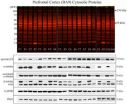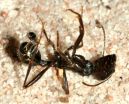(Press-News.org) This news release is available in Spanish.
Joint research between the University of the Basque Country (UPV/EHU) and the University of Nottingham has identified, for the first time, the structural damage caused at a molecular level to the brain by the chronic excessive abuse of alcohol. In concrete, the research team has determined the alterations produced in the neurones of the prefrontal zone of the brain (the most advanced zone in terms of evolution and that which controls executive functions such as planning, designing strategies, working memory, selective attention or control of behaviour. This research opens up pathways for generating new pharmaceutical drugs and therapies that enhance the life of alcoholic persons and reduce the morbimortality due to alcoholism. The research was published in the digital journal specialised in biomedical sciences, PLOS One with an impact factor of 3.730.
In the research, doctors Luis F. Callado, Benito Morentin and Amaia Erdozain, from the UPV/EHU, together with doctor Wayne G. Carter's team from the University of Nottingham, analysed the postmorten brains of 20 persons diagnosed with alcohol abuse/dependence, alongside another 20 non-alcoholic brains. Studying the prefrontal cortex, researchers detected alterations in the neuronal cytoskeleton in the brains of alcoholic patients; in concrete, in the α- and β-tubulin and the β II spectrin proteins. These changes in the neuronal structure, induced by ethanol ingestion, can affect the organisation, the capacity for making connections and the functioning of the neuronal network, and could largely explain alterations in cognitive behavior and in learning, attributed to persons suffering from alcoholism.
The description of damage and alterations, now detected for the first time at a molecular level in the prefrontal zone of the brain, is the first step for investigation in other fields. Highlighted amongst the new targets put forward is to elucidate the concrete mechanism by which alcohol produces these alterations - to determine what the possible changes that the enzymes responsible for regulating the functioning of these proteins undergo, and to see if these processes also occur in other parts of the brain, for example, those controlling motor function. The final objective is to identify these molecular changes in order to be able to, on the one hand, link them with the processes of alcohol abuse and dependence and, on the other, generate new pharmaceutical drugs and therapeutic options that reverse the alterations produced by alcohol, enhancing the quality of life of alcoholic persons and reducing the mortality rate due to alcoholism.
The research process
The brain samples employed came from the collection of samples of the Neuropsychopharmacology Research Group at the Department of Pharmacology (UPV/EHU). These samples are a result of an agreement between the UPV/EHU and the Basque Institute of Legal Medicine. The diagnoses of the individuals were undertaken by the doctors responsible for the patients prior to their death, complying with the directives of the Diagnostic and Statistical Manual of Mental Disorders (DSM of the American Psychiatric Association).
In order to undertake the research, the researchers used techniques of optical microscopy, proteomics, Western blot and mass spectrometry. Optical microscopy demonstrated that the neurones in the prefrontal zone of the brains of the alcoholic patients had undergone alterations compared to those of non-alcoholic patients. In the following step, the research team used proteomic techniques, in order to identify which proteins were modified in these neurones. Thus, they determined that the altered elements belong to the families of proteins known as tubulins and spectrins. Tubulins make up the cytoskeleton of the neurones – their architecture. The spectrins are responsible for maintaining the cell shape. In this way, both facilitate the relation between and the activity of the components of the brain's neurone network.
With the objective of quantifying the quantity of protein in each sample, they used the Western blot technique, checking that the levels of proteins were reduced as a consequence of the damage produced by the ethanol. The next stage was using mass spectrometry, which enabled confirming the exact identification of the proteins affected; i.e. within the tubulin family they observed the reduction in the α and β proteins; while amongst the spectrins, they located a decrease in the β II protein.
INFORMATION:
The research team
Doctors Koldo Callado and Amaia Erdozain are members of the Neuropsychopharmacology Research Group, ascribed to the Department of Pharmacology at the UPV/EHU and currently led by J. Javier Meana. Their lines of research are focused on undertaking cooperative research with a clear translational vision, i.e. forming closer links between clinical and basic research. One of these lines of research is based on the study of neurochemical disorders directly observed in the post-mortem brain. Benito Morentin is Head of the Forensic Pathology Service at the Basque Institute of Legal Medicine and Associate Professor of the Department of Medical-Surgical Specialities of the UPV/EHU.
Bibliographical references:
Amaia M. Erdozain, Benito Morentin, Lynn Bedford, Emma King, David Tooth, Charlotte Brewer, Declan Wayne, Laura Johnson, Henry K. Gerdes, Peter Wigmore, Luis F. Callado, Wayne G. Carter "Alcohol-Related Brain Damage in Humans" Plos One (Published: April 03, 2014) DOI: 10.1371/journal.pone.0093586 http://www.plosone.org/article/info:doi/10.1371/journal.pone.0093586
Alcohol abuse damage in neurones at a molecular scale identified for first time
2014-06-12
ELSE PRESS RELEASES FROM THIS DATE:
David and Goliath: How a tiny spider catches much larger prey
2014-06-12
In nature, it is very rare to find a proverbial much smaller David able to overpower and kill a Goliath for supper. This is exactly the modus operandi of a solitary tiny spider from the Negev desert in Israel that routinely kills ants up to almost four times its own size. Details about how it attacks and kills its prey with a venomous bite is published in Springer's journal Naturwissenschaften – The Science of Nature. The study was led by Stano Pekár of Masaryk University in the Czech Republic.
Pekár's team observed the natural prey and predatory behavior of the minute ...
Survivors of childhood liver transplant at risk of becoming 'skinny fat'
2014-06-12
New research reports that survivors of childhood liver transplant remain nutritionally compromised over the long-term. Findings published in Liver Transplantation, a journal of the American Association for the Study of Liver Diseases and the International Liver Transplantation Society, indicate that the recipients' return to normal weight post-transplant was due to an increase in fat mass as body cell mass remained low, indicating a slim body composition with little lean muscle mass or "skinny fat."
Children with end-stage liver disease may be malnourished due to inadequate ...
Scientists closing in on new obesity drug
2014-06-12
Obesity and diabetes are among the fastest growing health problems in the world, and the hunt is in for a pill that can fight the problem. Now a Danish/British team has come up with a smart tool that will speed up the scientific hunting process, and we may be one step closer to a pill against obesity.
The body has a variety of functions that decide if we get overweight or not. For instance hormones control our appetite and the uptake of food. In recent years science has taken on the quest of investigating these physiological functions and finding a medical way to fight ...
Children showing signs of social withdrawal in risk of internalized distress
2014-06-12
Children are showing signs of social withdrawal are more susceptible to parental influences than others. These children were also more prone to distress caused by the impacts of guilt-inducing parenting.
The researchers of the University of Jyväskylä, Finland, have found that children showing signs of social withdrawal are more susceptible to parental influences than others. The researchers followed up about 300 children across the first three years of primary school and monitored the children's social skills and problem behaviors. At the same time, mothers' and fathers' ...
Recreational football can treat hypertensive and type 2 diabetes patients
2014-06-12
The studies, published in the acclaimed Scandinavian Journal of Medicine & Science in Sports, show that 24 weeks of twice-weekly recreational football training sessions lower blood pressure and improves heart function in men with high blood pressure and men with type 2 diabetes. Furthermore, men with type 2 diabetes lost 12 % of their abdominal fat and reduced their blood sugar 20% more than inactive control subjects.
These effects are likely to reduce the risk of developing heart diseases including heart failure and myocardial infarction, and the participants had a reduced ...
Does food addiction exist?
2014-06-12
Women with weight problems were more impulsive than average in a food-related psychology test, a new research paper has shown. This suggested that they are more instinctively stimulated by images of food as well as lacking contemplative will power. Further, some women reported food craving even if they had eaten recently, a symptom of possible food addiction.
"All addictions are similar in that the sufferer craves to excess the feel-good buzz they receive from chemical neurotransmitters produced when they eat, gamble, smoke, have sex or take drugs," commented Claus Voegele, ...
Blood product sterilization taken too far?
2014-06-12
Certain processes used to sterilize blood products could potentially cause serious health issues in transfusion recipients, according to an international study published in the journal Platelets and led by Dr. Patrick Provost of Université Laval's Faculty of Medicine and the CHU de Québec Research Center. These processes purportedly alter the blood platelets to the extent of preventing them from carrying out their functions correctly and may be the cause of hemorrhages observed in patients having received treated blood.
The function of platelets goes far beyond their ...
When good people do bad things
2014-06-12
CAMBRIDGE, MA -- When people get together in groups, unusual things can happen — both good and bad. Groups create important social institutions that an individual could not achieve alone, but there can be a darker side to such alliances: Belonging to a group makes people more likely to harm others outside the group.
"Although humans exhibit strong preferences for equity and moral prohibitions against harm in many contexts, people's priorities change when there is an 'us' and a 'them,'" says Rebecca Saxe, an associate professor of cognitive neuroscience at MIT. "A group ...
Study of white sharks in the northwest Atlantic offers optimistic outlook for recovery
2014-06-12
White sharks are among the largest, most widespread apex predators in the ocean, but are also among the most vulnerable. A new study, the most comprehensive ever on seasonal distribution patterns and historic trends in abundance of white sharks (Carcharodon carcharias) in the western North Atlantic Ocean, used records compiled over more than 200 years to update knowledge and fill in gaps in information about this species.
Scientists from NOAA Fisheries and colleagues added recent unpublished records to previously published data to present a broad picture of 649 confirmed ...
Antibodies from the desert as guides to diseased cells
2014-06-12
The use of nanoparticles in cancer research is considered as a promising approach in detecting and fighting tumour cells. The method has, however, often failed because the human immune system recognizes the particles as foreign objects and rejects them before they can fulfil their function. Researchers at the Helmholtz-Zentrum Dresden-Rossendorf (HZDR) and at University College Dublin in Ireland have, along with other partners, developed nanoparticles that not only bypass the body's defence system, but also find their way to the diseased cells. This procedure uses fragments ...


